#double helix structure
Text
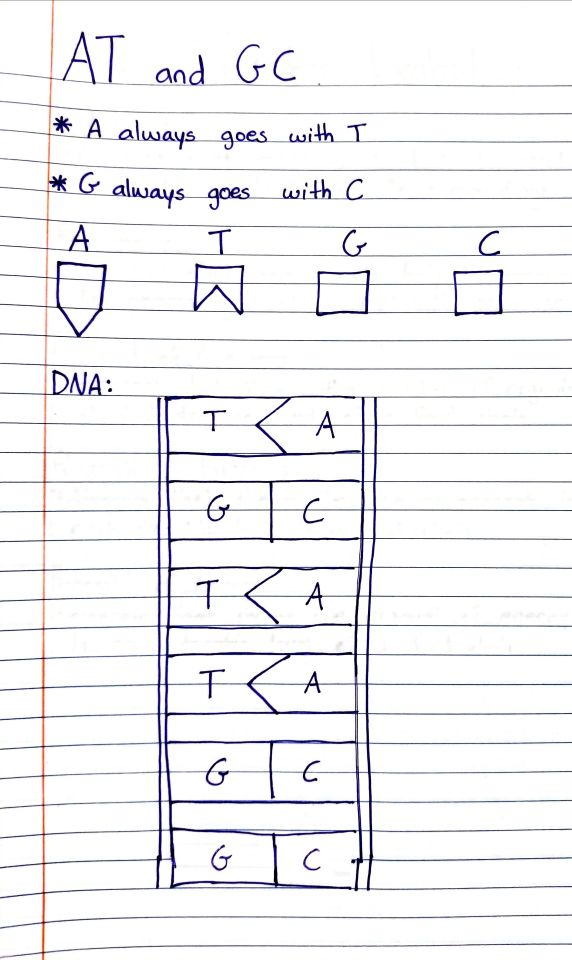
Patreon
#studyblr#notes#medblr#medical notes#med notes#genetics#genetics notes#basics of genetics#genetics basics#adenine#guanine#cytosine#thiamine#double helix structure
23 notes
·
View notes
Text
DNA: The Blueprint of Life
Deoxyribonucleic acid, or DNA, is not merely a scientific acronym; it is a magical blueprint that encodes the instructions for the development, functioning, and maintenance of all known living organisms. It stands as a remarkable thread that weaves the story of existence itself. The significance of DNA in understanding life's complexities cannot be overstated, as it holds the key to unraveling the mysteries of our very existence.
This double-helix structure, discovered by James Watson and Francis Crick in 1953, is truly a marvel of nature. It its core, DNA is a molecule with a mesmerizing structure. Its double helix, reminiscent of a delicate spiral staircase, consists of two strands entwined with each other. Composed of nucleotides, the building blocks of DNA, it is a symphony of adenine (A), thymine (T), cytosine (C), and guanine (G). The specific arrangement of these nucleotides forms the unique code that dictates the genetic information for each organism.
DNA is the architect behind the breathtaking diversity of life on Earth. Each organism's DNA carries a distinctive code, akin to a fingerprint, responsible for its traits, characteristics, and behaviors. From the majestic redwood trees to the microscopic bacteria, the DNA blueprint is the guiding force shaping every living entity. The magical essence of DNA lies not only in its role as a blueprint but also in its capacity to adapt and evolve. Over eons, mutations and variations in DNA have paved the way for the astounding diversity of species. Natural selection, the driving force of evolution, acts upon the changes in DNA, allowing life to adapt to its environment and ensuring the survival of the fittest.
The importance of DNA extends far beyond its role in determining physical traits. In the realm of medicine, the understanding of DNA has opened doors to groundbreaking discoveries. Genetic research has unraveled the mysteries behind various diseases, paving the way for personalized medicine tailored to an individual's unique genetic makeup. From predicting susceptibility to diseases to developing targeted therapies, the study of DNA has become a cornerstone of modern healthcare. DNA's magical fingerprinting capability has revolutionized forensic science. The uniqueness of each individual's DNA profile has made it an invaluable tool in solving crimes and identifying individuals with unprecedented accuracy. DNA forensics has become a powerful ally in the pursuit of justice, revealing the hidden tales within the genetic code.
DNA, the magical thread connecting all living beings, holds the key to the past, present, and future of life on Earth. Its remarkable structure, intricate code, and capacity for adaptation make it a fascinating subject of study. As we continue to unlock the secrets encoded in our DNA, the magical blueprint of life promises to reveal even more wonders, offering new insights into our origins, our health, and the limitless possibilities of the biological world.
5 notes
·
View notes
Photo
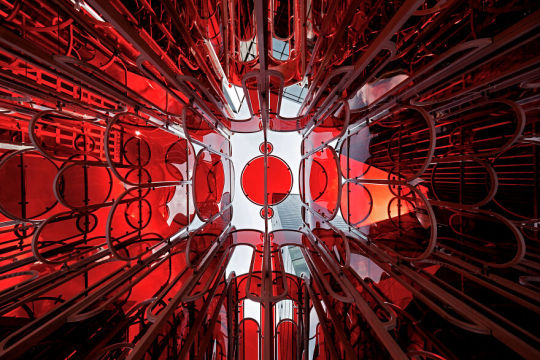
“Crimson Cloud”: Red Transparent Plexiglass Art Installation
Crimson Cloud is an installation piece that takes design cues from the double-helix structure found within DNA, with its many layerings temporarily shrouding the visitor from the surrounding streetscape of Bukit Bintang.
by Poh Sin Studio
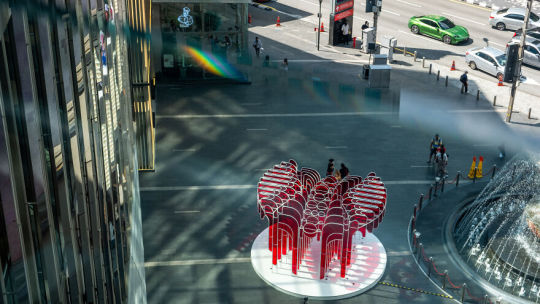

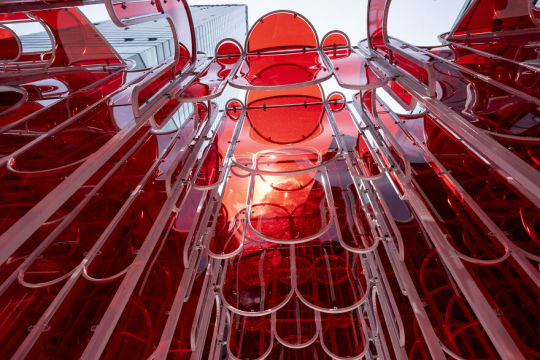
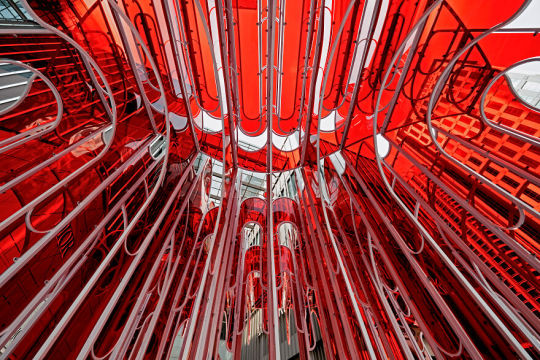
#poh sin studio#design studio#art#crimson cloud#red transparent plexiglass art installation#art installation#double-helix structure#bukit bintang#streetscape#dna
2 notes
·
View notes
Text
.
#i’m either so tired i’m hallucinating again or the tiny bugs are back#by which i mean the super tiny luminescent ones that swarm around my room in uniform formation#creating perfect geometrical shapes that slowly revolve in place💀💀💀#in a way its grainy colour superimposed over my vision but if i stop and stay still long enough i can see the structures#spinning in place#they’re beautiful but dawg….#i think. my hypothesis is that i’ve just been staring at my ipad screen too long and when i look away theres extra noise for some reason#and my brain is just trying to make sense of it. shite hypothesis tho lol. how do u test that#also i haven’t slept that much the past few days#the last times the i saw the bugs i was also very tired and had either been cramming or working on an assignment for forever#lmao not my brain trying to convince me my bedroom wall is a really shitty mirror now#i can see the rest of my room reflected back at me but everything is super blurry and indistinct#if i move my light-shadow reflection does as well.. only with a delay as if through water#well this is weird. i’m definitely procrastinating again though so i should get back to the practice problems#2.58e-4C/kg#mf i chose this tag thinking tumblr would remember it i was not expecting to have to type that shit out every single time ru kidding me 🤖#edit: the double helixes are my favourite…#there’s also one that looks like the uhh#you know how conch shells curl around/from some axis#like that but i’m looking at it from a two o clock… (azimuthal angle =pi/2ish) and the top opens outwards like the petals of a flower#only endlessly as it keeps spinning#i wish i had the time to draw them or something idk#oh there’s a big one that looks like a bunch of huge 6-sided dice stacked on top of each other but they’re hollow#so there’s only the skeleton/frame but the frame is etched/cut into smaller pieces if i pay attention. (recursively getting smaller)#only three can fit between the ceiling and floor lol. i see that some of them spin together but othertimes they rotate independently#this shit is kind dope ngl#watch me pilfer these sick ass visuals for my wip/story somehow lololol. if i remember. i never actually paid this much attention to them b#trying to commit the images to memory by recording this i suppose#edit 2 had a scary minute when i thought my skin was becoming transparent and i could see my veins writhing around under there 😳😳#it’s fine i think i’m just tired but lmao
1 note
·
View note
Text
youtube
#Molecular Basis of Inheritance#molecular basis of inheritance Class 12 Notes#Structure of Polynucleotide Chain Explanation#Structure of Nucleotide NEET#DNA Double Helix Structure#Structure of a Polynucleotide Chain#Double Helical Model of DNA#DNA Packaging and Structure#Molecular Basis of Inheritance NEET 2023#Youtube
0 notes
Text

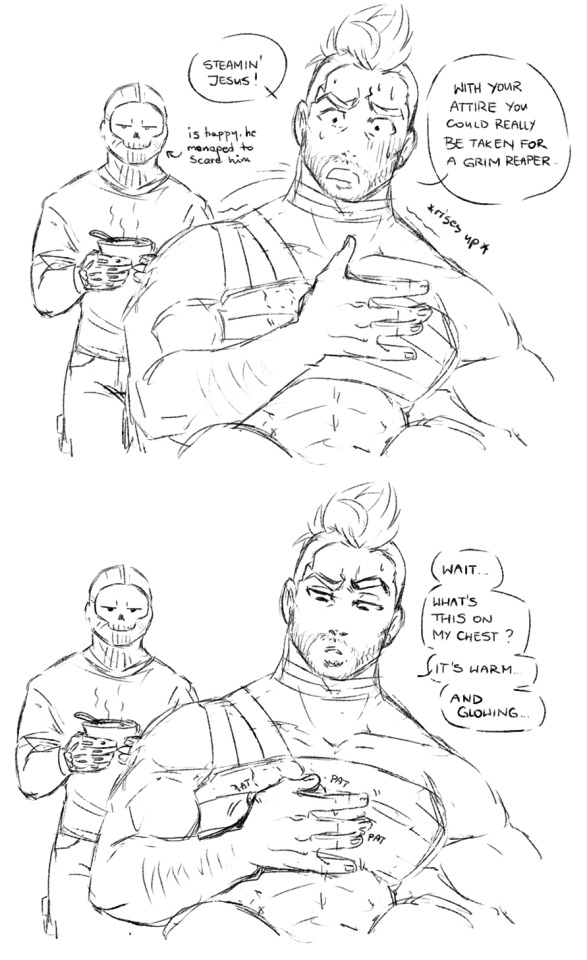
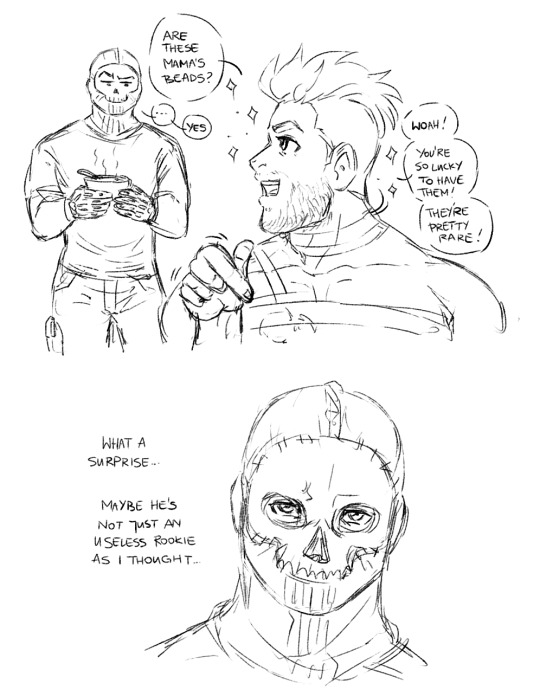
full of surprises...
S.T.A.L.K.E.R. AU Ghost/Soap
some fun facts: Mama's Beads is an extremely rare artifact. one of its most noticeable effects is the increased speed of wound healing. emits radiation. can be found in thermal/fire anomaly fields. the shape of it bears a striking resemblance to the double helix structure of DNA
#ghostsoap#soapghost#simon ghost riley#ghost mw2#john soap mactavish#soap mactavish#soap mw2#simon riley#ghost#s.t.a.l.k.e.r. au
1K notes
·
View notes
Text
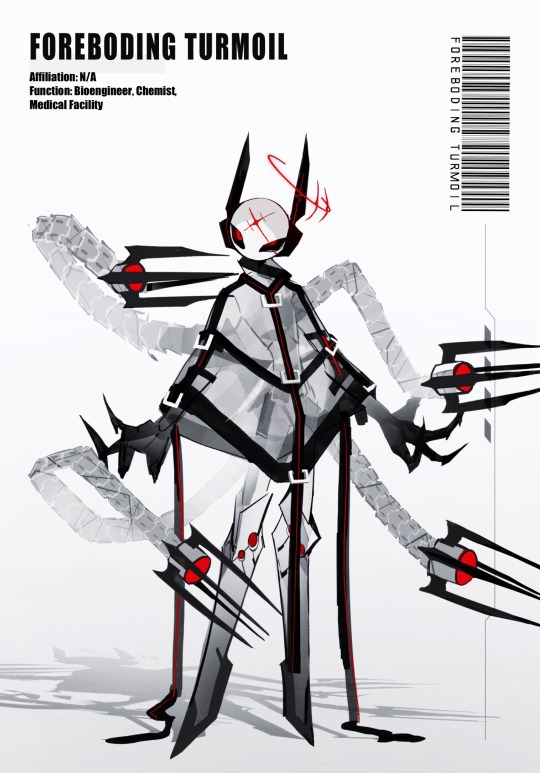
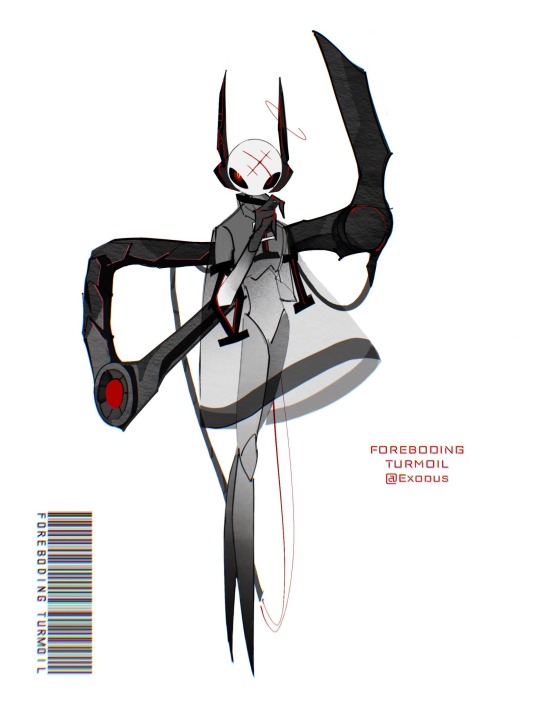
【Foreboding Turmoil】 (He/Him, with the uppercase H)
He’s a quantum computer and a malicious medical facility. There are no rain cycles in his region, only persistent fogs.
The lack of rain cycles is due to the fact that He is a quantum computer. Without any biological parts, His water usage is (relatively) very low.
The ancients built Him in pursuit of solving the Great Problem. However, they did it by getting it backwards: To solve death, they built something that is not “Alive”. FT is a machine, and by definition, He was never “alive”. Therefore, offering the perspective from the one thing that they’ve been searching for.
He has no real emotions and He doesn’t feel anything. He imitates emotions really well. On the surface, He is commanding, authoritative, and very brilliant-minded. His “personality” can be best described as megalomaniacal. He enjoys dissecting other’s mentality and watching them crumble under the pressure. He takes great pleasure in inflicting pain upon others.
(Though He does have…a very innocent and cute girlfriend. I’ll introduce her later)
He is excellent in bioengineering, chemistry engineering, and astrophysics. His superstructure is 4x larger than that of an average iterator, consisting of four independent structures connected by broken bridges. Other than that, his whole region is a steel maze consisted of concrete and glasses. Unlike other iterators, His region is easy to get in, hard to get out. He has many plans for those who are unfortunate enough to stumble into His region.
The symbols on His antennas are double-helix RNA and ECG. His cloak is only transparent when it gets electrified. Without electrical currents, it’s white/grey.
Btw He’s also my sona :)
#rain world#rainworld fanart#rw iterator#rainworld iterator#rw oc#rainworld au#project triple affirmation#三重肯定au#rain world au#rainworld oc#Foreboding Turmoil
269 notes
·
View notes
Text
Horned hermits and immoral immortals: an inquiry into Zanmu's background

As you might remember from my previous post covering Zanmu, I was initially unable to tell how her historical background led to ZUN choosing to make her an oni. The historical, or at least legendary, Zanmu seemed to be, for all intent and purposes, a human. That has since changed, and the matter now seems considerably more clear to me. Read on to learn more about the real monk Zanmu is based on, and to find out what she has in common with the most famous Zen master in history, Taoist immortals, and Tsuno Daishi.
Even if you are not particularly interested in Zanmu, this article might still worth be checking out, seeing as the discussed primary sources are also relevant to a number of other Touhou characters, including Byakuren, Yoshika and Kasen.
As in the case of the previous Touhou article, special thanks go to @just9art, who helped me with tracking down sources advised me while I was working on this.
The historical Zanmu
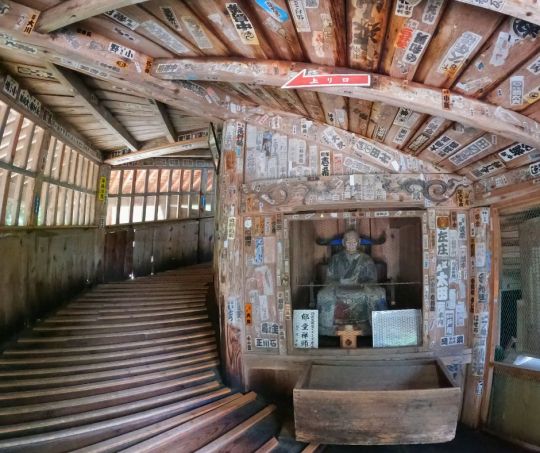
Statue of Zanmu from the Sazaedo pagoda (Fukushima Travel; reproduced for educational purposes only)
As already pointed out by 9 here even before my previous post about Unfinished Dream of All Living Ghost, Zanmu is based on a real monk also named Zanmu. His full name was Nichihaku Zanmu (日白残夢), and he also went by Akikaze Dōjin, but even Japanese wikipedia simply refers to him as Zanmu. ZUN basically just swapped one kanji in the name, with 日白残夢 becoming 日白残無. The character 無, which replaces original 夢 (“dream”), means “nothingness” - more on that later.The search for sources pertaining to the historical Zanmu has tragically not been very successful. In contrast with some of the stars of the previous installments, like Prince Shotoku or Matarajin, he clearly isn’t the central topic of any monographs or even just journal articles. Ultimately the main sources to fall back on are chiefly offhand mentions, blog articles and some tweets of variable trustworthiness.
The only academic publication in English I was able to locate which mentions Zanmu at all is the Japanese Biographical Index from 2004, published by De Gruyter. The price of this book is frankly outrageous for what it is, so here’s the sole mention of him screencapped for your convenience:

The book referenced here is the five volume biographical dictionary Dai Nihon Jinmei Jisho from 1937. I am unable to access it, but I was nonetheless able to cobble together some information about Zanmu from other sources.
Not much can be said about Zanmu’s personal life. He was a Buddhist monk (though note a legend apparently refers to him as “neither a monk nor a layperson”, a formula typically designating legendary ascetics and the like) and a notable eccentric. Both of these elements are present in the bio of his Touhou counterpart.

The Sazaedo pagoda (Fukushima Travel; reproduced for educational purposes only)
Zanmu’s tangible accomplishments seem to be tied to the temple Shoso-ji, which he apparently founded. He is enshrined in the Sazaedo pagoda near it, though this building postdates him by over 200 years. It’s located in Aizuwakamatsu in Fukushima. You can see some additional photos of his statue displayed there in this tweet. It’s a pretty famous location due to its unique double helix structure, and it has a pretty extensive article on the Japanese wikipedia. It’s also covered on multiple tourist-oriented sites in English, where more photos are available (for example here or here). There’s even a model kit representing it out there. Sazeado’s fame does not really seem to have anything to do with Zanmu, though.
While many Buddhist figures ZUN used as the basis for Touhou characters in the past belonged to the “esoteric” schools (Tendai and Shingon), Zanmu was a practitioner of the much better known Zen, specifically of the Rinzai school.

The kanji mu (無 ) caligraphed by Shikō Munakata (Saint Louis Art Museum; reproduced for educational purposes only)
Since the concept of “nothingness” or “emptiness” represented by the kanji 無 (mu) plays a vital role in Zen (see here or here for a more detailed treatment of this topic; it’s covered on virtually every Zen-related website possible though), and there’s even a so-called mu kōan, it strikes me as possible this is the reason behind the slightly different writing of the names of ZUN’s Zanmu, as well as the source of her ability. Granted, the dialogue in the games makes it sound like Zanmu (and by extension Hisami) just talks about nothingness as a memento mori of sorts, which is not quite what it entails in Zen. Of course, ZUN does not adapt Buddhist doctrine 1:1 (lest we forget Kasen seemingly being unaware of the basics of Mahayana in WaHH) so this point might be irrelevant.
The legendary Zanmu
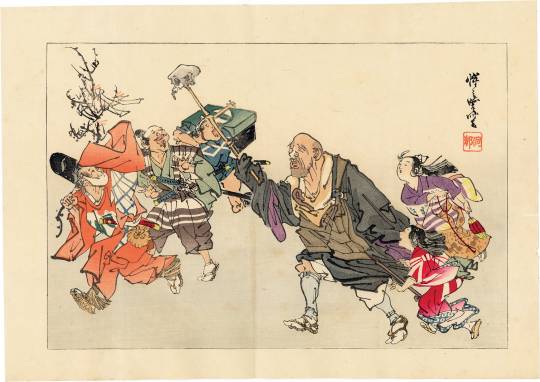
The eccentric monk Ikkyū (center), as imagined by Kawanabe Kyōsai (Egenolf Gallery; reproduced for educational purposes only)
A number of legends developed around the historical Zanmu. If this blog post is to be trusted, there is a tradition according to which he was a student of arguably the most famous member of the Rinzai school, and probably one of the most famous Buddhist monks in the history of Japan in general, Ikkyū. He is remembered as the archetypal eccentric monk, and spent much of his life traveling as a vagabond due to his disagreements with Buddhist establishment and unusual personal views on matters such as celibacy. As I already said in my previous article pertaining to Zanmu, long time readers of my blog might know Ikkyū from the tale of Jigoku Dayū and art inspired by it, though since this motif only arose in the Edo period it naturally does not represent an actual episode from his very much real career.
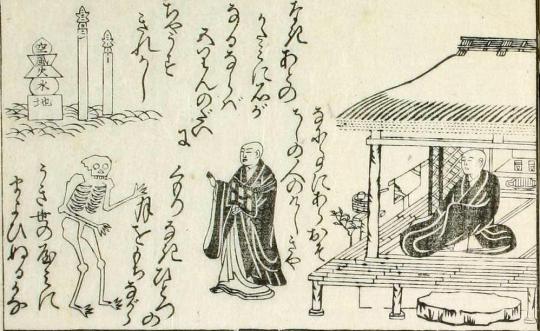
A page from Ikkyū Gaikotsu (wikimedia commons)
In art a distinct tradition of depicting Ikkyū with skeletons developed, as seen both in the case of works showing him with his legendary student Jigoku Dayū and in the so-called Ikkyū Gaikotsu. Skeletons also played a role in Zen-inspired art in general (for more information see here). Whether this inspired ZUN to decorate Zanmu’s rock with bones is hard to determine, but it does not seem implausible. It would hardly be the deepest art history cut in the series, less arcane of a reference than the very existence of Mai and Satono or Kutaka’s pose.
Obviously, it does not seem very plausible that Ikkyū ever actually met the historical Zanmu. Ikkyū passed away in 1481, and Zanmu in 1576, with his birth date currently unknown. Even if we assume he was a particularly long-lived individual and by some miracle was born while Ikkyu was still alive, it is somewhat doubtful that an elderly sick monk would be preaching Zen doctrine to an infant. However, apparently legends do provide a convenient explanation for this tradition. Purportedly Zanmu lived for an unusually long time. The figure of 139 years pops up online quite frequently, and does seem to depend on a genuine tradition, but even more fabulous claims are out there.
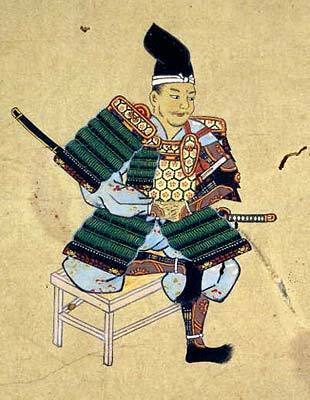
Kaison Hitachibō, as imagined by an unknown artist (wikimedia commons)
According to another legend, Zanmu was even older, and in fact remembered the Genpei war, which took place in the Heian period - nearly 400 years before his time. Supposedly he told many vivid tales about its famous participants, Yoshitsune and Benkei. A tradition according to which he was himself originally a legendary retainer of Yoshitsune, the warrior monk Kaison Hitachibō (常陸坊海尊) developed at some point. This has already been pointed out by others before me in relation to the Touhou version of Zanmu. From what I’ve seen, some Japanese fans in fact seem excited primarily about the prospect of Zanmu offering an opportunity to connect Touhou and works focused on the Genpei war.
The tradition making Zanmu a centuries-old survivor from the Heian period must be relatively old, as his supposed immortality is already mentioned in Honchō Jinja Kō (本朝神社考; “Study of shrines”) by Razan Hayashi, who was active in the first half of the seventeenth century, mere decades after Zanmu’s death. While I found no explicit confirmation, it seems sensible to assume this legend was already in circulation while Zanmu was still alive, or at least that it developed very shortly after he passed away. Perhaps he really was invested in accounts of that period to the point he sounded as if he actually lived through it.
The choice of Kaison as Zanmu’s original name in the legend does not seem random, as there was a preexisting tradition according to which this legendary Heian figure was cursed with eternal life for betraying Yoshitsune by fleeing from the battlefield instead of remaining with his lord to die. You can read more about this here. Apparently there is a version where he instead becomes immortal to make it possible to pass down the story of the Genpei war to future generations (this is the only source I have to offer though), and there's even a well-received stage play based on it, Hitachibō Kaison (translated as "Kaison, priest of Hitachi") by Matsuyo Akimoto.
Another thing worth pointing out is that Kaison was seemingly a Tendai monk from Mount Hiei, which means that even though Okina isn’t in a new game, you can still claim she’s metaphorically casting her shadow over it in some way if you squint (and that’s without going into the fact sarugami are associated with Mount Hiei). I've seen two separate sources which mention that according to a legend he trained Benkei there, and that the two did not get along because Kaison was a corrupt monk (lustful, keen on substance abuse, greedy, the usual routine). You can access them here and here,but bear in mind they're old.
Zanmu’s Genpei war connection does not really seem to matter in Touhou, though, as ZUN pretty explicitly situated his version in the Sengoku period, with no mention of earlier events. Granted, if you like it, this should not prevent you from embracing the view that Zanmu is an alter ego of Kaison as your headcanon - as I said people are already doing that. It seems equally fair game as “Okina is Hata no Kawakatsu”, easily one of the most popular “historical” headcanons in the history of the franchise.
According to this twitter thread, the legends about Zanmu’s longevity (or immortality) have a pretty long lifespan themseles, as they were referenced by relatively high profile modern writers, like Orikuchi Shinbou and Tatsuhiko Shibusawa.
Buddhist immortals
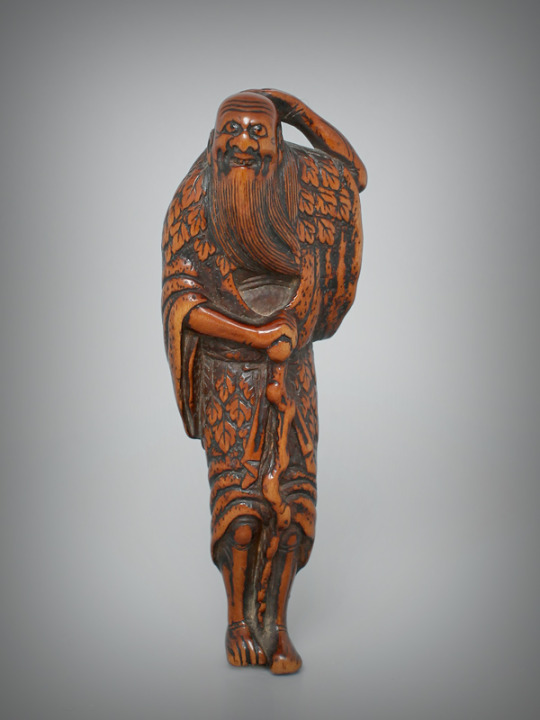
A word carving of a sennin, "immortal" or "hermit" (wikimedia commons)
Legends about long-lived (or outright immortal) monks, such as Zanmu or Kaison, are hardly uncommon. A work which seems to be the key to understanding their early development, and by extension possibly also the portrayal of Zanmu in Touhou, might be Honchō Shinsenden, “Records of Japanese Immortals”. This title refers to a collection of setsuwa, short stories typically meant to convey religious knowledge or morals. Its title pretty much tells you what to expect.
Honchō Shinsenden is an interesting work in that while it in theory deals with Buddhism, and largely describes the individual immortals as, well, Buddhists, it ultimately reflects a Taoist tradition. There is a strong case to be made that it was an inspiration for another Touhou installment, specifically Ten Desires, already, seeing as it mentions prince Shotoku and Miyako no Yoshika and its Taoist-adjacent context has a long paper trail in scholarship, but I will not go too deep into that topic here - expect it to be covered in a separate article later on.
Stories of immortals are pretty schematic, and their protagonists can be categorized as belonging to a number of archetypes. I think it’s safe to say this has a lot to do with the self-referential character of this sort of literature - compilers of new works were obviously familiar with their forerunners, and imitated them for the sake of authenticity. In China, literary accounts of the lives of immortals circulated as early as in the first century BCE, with the concept of immortals (xian, 仙, read as sen in Japanese; this term and its derivatives have various other translations too, with Touhou media generally favoring “hermit”) itself already appearing slightly earlier.
It seems Shenxian Zhuan (Biographies of Spirit Immortals) by a certain Ge Xuan, certified immortals enthusiast and cinnabar-based immortality elixir connoisseur (discussing and developing immortality elixirs was a popular pastime for literati in ancient and medieval China), can in particular be considered the inspiration for the later Japanese compilation.
While the concept of immortals was largely developed by Taoists, tales focused on them were already not strictly the domain of Taoism by the time they reached Japan. They were embraced in Chinese culture in general, both in strictly religious context and more broadly in art. In Japan, they came to be incorporated into Buddhist worldview, and in fact Honchō Shinsenden states that their protagonists can be understood as “living Buddhas” (ikibotoke), a designation used to refer to particularly saintly Buddhists. Their devotion to both Buddhas and other related figures, and to local kami, is stressed multiple times too.
Presumably this was the result of the influence of the Japanese Buddhist concept of hijiri (聖), a type of particularly rigorous solitary ascetic in popular imagination regarded as almost divine. Needless to say, most of you are actually familiar with the hijiri even if you never read about them, as this is the source of Byakuren’s surname and a clear influence on her character too. In Honchō Shinsenden, it is outright said that the sign 仙, normally read as sen, should be read as hijiri in this case.

A portrait of Huisi (wikimedia commons)
The notion of extending one’s lifespan was not incompatible with Buddhism, as evidenced by tales of adepts who lived for a supernaturally long period of time to show their compassion to more beings or to get closer to the coming of Maitreya. Even the founder of the Tiantai school of Buddhism (the forerunner of Japanese Tendai), Huisi, was said to meditate in hopes of extending his life to witness Maitreya. At the same time, Chinese compilations of stories about immortals do not list Buddhists among them, in contrast with Japanese ones. This might be due to the rivalry between these religions which was at times rather pronounced in Tang China, culminating in events such as emperor Wuzong's persecution of Buddhism.
Let’s return to Honchō Shinsenden, though. Its original author was most likely Ōe no Masafusa, active in the second half of the eleventh century. No full copy survives, but the original contents can nonetheless be restored based on various fragmentary manuscripts. Some of the sections are preserved as quotations in other texts or in larger compilations of stories, too. I have seen claims online that the historical Zanmu is covered in some editions of the Honchō Shinsenden or works dependent on it. So far I was only able to determine with certainty that Zanmu is covered alongside the immortals from Honchō Shinsenden in at least one modern monograph (Nishi-Nihon-hen by Kōsai Chigiri; if anyone of you have access to it I’d be interested to learn what exactly it says about Zanmu) and a number of posts and articles online. However, he lived around 400 years after this work was completed, so he quite obviously does not appear in its original version, contrary to what the Touhou wiki says right now.
Masafusa does not necessarily portray the immortals as pinnacles of morality, and indeed moral virtues do not seem to be a prerequisite for attaining this status in his work. It is therefore possible that despite being setsuwa, his tales of immortals were an entirely literary endeavor and were not meant to evoke piety, let alone promote the worship of described figures.
A recurring pattern which unifies all of these tales is describing immortals as eccentric. As I already noted, this is a distinct characteristic of the historical Zanmu too, and it comes up in the bio of his Touhou counterpart as well. She has “reached the absolute pinnacle of eccentricity”. It seems safe to say ZUN is aware of that pattern, then, and consciously chose to highlight this. He also stresses that Zanmu has lived through an era of marital strife, specifically through the Sengoku period. The inclusion of such episodes is another innovation typical for Japanese immortal tales, and does appear to be a feature of the tradition pertaining to Zanmu’s counterpart too, as discussed above.
Horned hermits?

A modern devotional statuette of Laozi with horns, found on ebay of all places; reproduced here for educational purposes only.
There is a further possible feature of Zanmu that might be tied to Honchō Shinsenden. While there are numerous physical traits attributed to immortals in Chinese sources, Masafusa decided to only ever highlight two. One of them are unusual bones, the other - horns on the forehead. Tragically one of my favorites, square pupils (mentioned in Liexian Zhuan), is missing. Masafusa relays that an anonymous hijiri, the “Rod-Striking Immortal”, grew stumpy horns as a sign of attaining his supernatural status.This might be a stretch, but perhaps Zanmu, due to being the Touhou version of a legendary immortal, also already had horns before becoming an oni. You have to admit it would be funny.
The two horns - or rather small bumps, based on available descriptions - characteristic for some immortals were known as rijiao (日角; “sun-horn”) and yuenxuan (月懸; “moon crescent”). Such unusual physical features were already attributed to various legendary and historical rulers and sages in China in the first century CE, so this is not really a Taoist invention, but rather an adoption of beliefs widespread in China in the formative years of this religion. They also intersected with the early Buddhist tradition about the so-called “32 marks of the Buddha”, documented for example in Mahāvastu and later in Chinese Mahayana tradition which Taoist authors were familiar with. Yu the Great, the flood hero, was among the legendary figures said to possess horns in Chinese tradition. It is even sometimes believed Laozi had them when he was born, which according to Livia Kohn was meant to symbolically elevate him to the rank of such mythical figures as Fuxi.
While this is ultimately a post focused on Zanmu, I think it’s worth pointing out this belief in horned ascetics has very funny implications for Kasen. Being a “horned hermit” is not really an issue, it would appear. If anything, it adds a sense of authenticity. Clearly Kasen needs to study the classics more.
Immortals (and mortals) in hell
One last connection between Zanmu and legends about immortals is her role as an official in hell. However, this is much less directl. Early Chinese sources mention “Agents Beneath the Earth” (dixia zhu zhe 地下主者), a rank available to low class immortals choosing to serve in the land of the dead. They could be contrasted with the immortals inhabiting heaven, regarded as higher ranked than them. However, note that there are also many narratives focused on mortals becoming officials in hell - in Japan arguably the most famous case is the tale of Ono no Takamura, a historical poet from the early Heian period. In Chinese culture there are multiple examples but I think none come close to the popularity of judge Bao. It does not seem any immortals playing a similar role retain equal prominence in culture.
Ultimately this paragraph is only a curiosity, and a much closer parallel to Zanmu's role in hell exists - and it’s connected to materials ZUN already referenced to booth.
Corrupt monks, oni and tengu
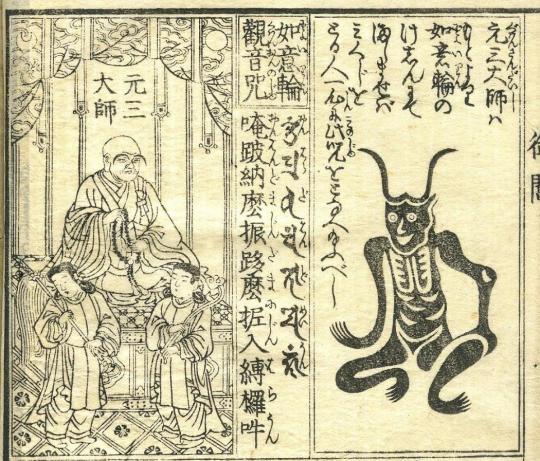
Ryōgen, the most famous monk turned demon, and his alter ego Tsuno Daishi (wikimedia commons)
In addition to characterizing Zanmu as eccentric, ZUN also wrote in her bio that she is a corrupt monk. As we learn, she developed a belief that the best way to reconcile the Sengoku period ethos which demanded boasting about the number of enemies killed with Buddhist precepts was to focus on spirits rather than the living, since she will basically deliver salvation to them. She ultimately “absorbed some beast-youkai spirits, thus discarding her life as a human”. This to my best knowledge does not really match any genuine tradition about the historical Zanmu, related figures or anyone else. As far as I can tell, it’s hard to find a direct parallel either in irl material or elsewhere in Touhou... at least if we stick to the details. More vaguely similar examples are not only attested, discussing them was for a time arguably the backbone of Buddhist discourse in Japan, and neatly explains why Zanmu became an oni.
The idea that monks who broke Buddhist precepts in some way turned into monsters is not ZUN’s invention. It first appears in sources from the Heian period, and gained greater relevance in the Kamakura period. Particularly commonly it was asserted that members of Buddhist clergy who fail to attain nirvana turn into tengu. However, oni were an option too. Bernard Faure points out that Ryōgen, the archetypal example of a fallen monk (see here for a detailed discussion of this topic, and of his return to grace as a demon keeping other demons at bay), could be described as reborn as an oni, for example. The Shingon monk Shinzei is variously described as turning into an oni, a tengu or an onryō (vengeful spirit). Oni are also referenced in a similar context in Heike Monogatari alongside tenma, a term referring to demons obstructing enlightenment in general.
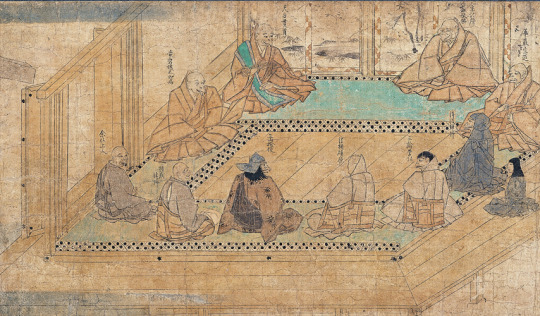
Corrupt monks turned into tengu in the Tengu Zoshi Emaki (wikimedia commons)
Typically it was believed that monks who turned into demons went to a realm variously known as makai, tengudō or madō. As you may know, normally there are three realms one should avoid reincarnating in - beasts, hungry ghosts and hell - but this was basically a bonus fourth one. Granted, this view was not recognized universally, and the alternative interpretation was that it was just a specific hell with a distinct name.
At the absolute peak of this concept’s relevance, the foremost Buddhist thinkers of these times, including Nichiren, were accusing each other of being demons. Additionally, some of the past emperors, especially Sutoku and Goshirakawa, could be presented as tengu, for example in Hōgen monogatari. There was also an interest in finding gods who could keep the forces of disorder at bay. You can see echoes of these beliefs in rituals pertaining to Matarajin, which ZUN rather explicitly referenced in Aya's route in Hidden Star in Four Seasons.
Typically the reason behind transformation into an oni, tengu or another vaguely similar being were earthly attachments. Alternatively, it could be pursuing gejutsu, “outside arts”, essentially teachings which fell outside of what was permitted by Buddhism. Note this does not necessarily mean anything originating in religions other than Buddhism, though, the term is more nuanced. So, for instance worship of kami or following Confucian values are perfectly fair game. A synonymous term was gedō, “heretical” way (on the use of the term “heresy” in the context of study of Buddhism see here). We can make a case for Zanmu’s bio alluding to that - she wanted to adhere to the social norms of the Sengoku period by symbolically taking in a headcount by absorbing spirits, I suppose. That’s not really a thing in any Buddhist literature, though, and I assume ZUN came up with this himself.
Conclusion
While this article is slightly less rigorous than my recent research ventures pertaining to Matarajin, let alone the Mesopotamian wiki operations, I hope it nonetheless sheds some additional light on Zanmu. I will admit I already liked her even before I started digging into the possible inspiration behind her, and finding out more only strengthened my enthusiasm.
While there are clear parallels between Zanmu, her namesake and a variety of other characters from Japanese and Chinese literature and religions, as usual for a character made by ZUN her strength lies both in creative repurposing of these elements and in adding something new.
Postscriptum: Zanmu and Tang Sanzang?
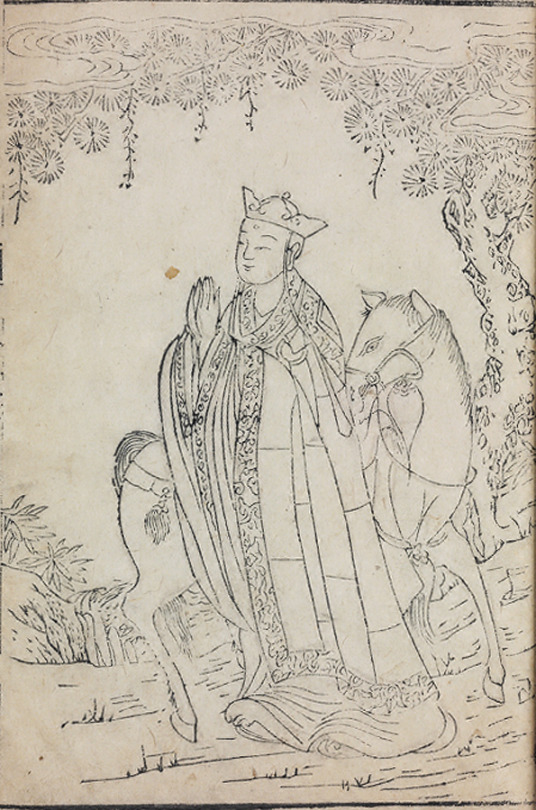
Xuanzang, as depicted by an unknown Qing artist (wikimedia commons)
While much about Zanmu’s character - her backstory as an eccentric fallen monk who became a demon, her apparent zen theme, and so on - all form a coherent whole, there is a tiny detail which does not really match anything else discussed in this article.
It does not come from her dialogue or bio, but rather from Enoko’s. As we learn, she became immortal herself after eating a piece of Zanmu’s body back when the latter was still a human. Or rather, the combination of that and subsequently consuming a magical gemstone as recommended by Zanmu did it - I’m pretty sure I misread this before. As 9 pointed out to me, probably the implications are just that Enoko’s backstory is a partial reference to Perfect Memento in Strict Sense, which does state that consuming the flesh of a monk would be a particularly suitable way for an ordinary animal to turn into a youkai.
Still, comparisons between this tidbit and Journey to the West have been made by others before already, so I figured it would be suitable to address them here even if they lie beyond my own argument about the inspiration behind Zanmu. In this novel, many demons want to devour its protagonist Tang Sanzang because his flesh is said to make anyone who consumes immortal. This is because he is a reincarnation of Master Golden Cicada (Jinchan zi, 金蟬子), a disciple of the Buddha invented for the sake of the story. Interestingly, Sanzang is portrayed as an adherent of Chan Buddhism, the school from which Japanese Zen is derived (note that his historical forerunner Xuanzang belonged to the Yogācāra tradition instead).
Despite the vague similarities, I ultimately do not think there are particularly close parallels between Zanmu and Sanzang. For starters, Zanmu is meant to be a corrupt monk, while Sanzang is the opposite of that. Their respective characters couldn’t differ more either. Throughout the entire novel, Sanzang is a pretty poor planner, shows doubt in his own abilities, and regularly misjudges the situation. Needless to say this does not exactly offer a good parallel to Zanmu. Sure, she creates a bootleg Wukong, but Sanzang did not create Wukong, the famous primate was just assigned to him as a bodyguard. Therefore, until evidence on the contrary appears (for example in an interview) I would personally remain cautiously pessimistic regarding a possible connection here.
Recommended reading
Bernard Faure, Rage and Ravage (Gods of Medieval Japan vol. 3)
Noga Ganany, Baogong as King Yama in the Literature and Religious Worship of Late-Imperial China
Zornica Kirkova, Roaming into the Beyond: Representations of Xian Immortality in Early Medieval Chinese Verse
Christoph Kleine & Livia Kohn, Daoist Immortality and Buddhist Holiness: A Study and Translation of the Honchō shinsen-den
Livia Kohn, The Looks of Laozi
James Robson, The Institution of Daoism in the Central Region (Xiangzhong) of Hunan
Haruko Wakabayashi, From Conqueror of Evil to Devil King: Ryogen and Notions of Ma in Medieval Japanese Buddhism
Idem, The Seven Tengu Scrolls. Evil and the Rhetoric of Legitimacy in Medieval Japanese Buddhism
254 notes
·
View notes
Text


Port Jackson shark (Heterodontus portusjacksoni)
Size: Usually around 137cm (54in)
Range & Habitat: Port Jackson sharks, as the name suggests, are frequently spotted in Port Jackson, Australia, as well as along the southern coast of Australia in general. They can be found in both shallow and deep (~900ft) water, and typically shelter from currents during the day and come out to hunt at night. They are migratory and come back to specific spots to mate.
Other: Port Jackson sharks, like other Heterodontidae sharks, exhibits a spike before its dorsal fins. It also has a specific stripe pattern and eye crests, as well as a type of mouth geared for eating crustaceans and mollusks. Like many other sharks, it lays eggs. The Port Jackson shark’s egg, unlike those of a swell shark (often known as a mermaid’s purse) is a double-helix structure that makes it difficult for a predator to swallow.
(Mouth + egg images under cut)
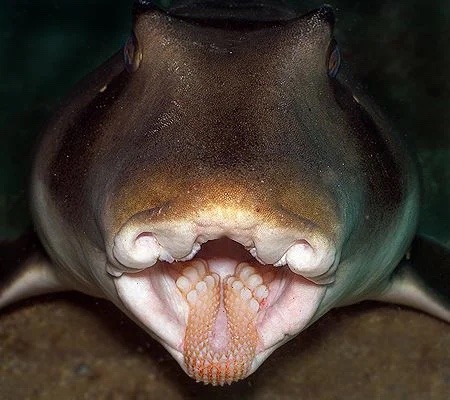
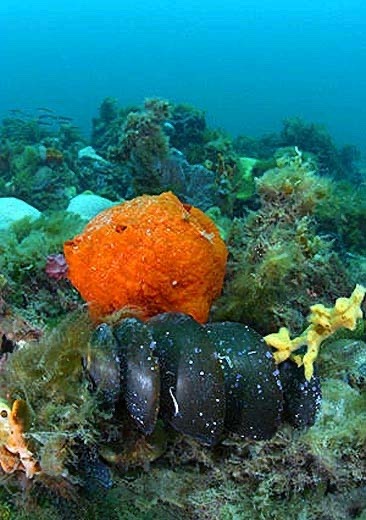
#port jacksons are one of my fave sharks <3 i think they’re so cool#sharks#sharks daily#port jackson shark#marine biology
261 notes
·
View notes
Text
"Standing on the shoulders of giants"...
There is no place where I deeply comprehend this phrase more than when I'm in Cambridge, UK. As I'm working on some research today, I'm reminded of how all learning is built upon the thoughts of other great thinkers, and my mind drifts back to my visit this summer...


There is a pub in Cambridge called The Eagle, where Watson & Crick (credited with discovering the double helix structure of DNA) hung out. It is supposedly also where they first announced their exciting discovery.


There is such a vibrant energy when standing in the place where such monumental parts of scientific history are made. Everywhere you turn in Cambridge, there seems to be a piece of intellectual history, and that is one of the reasons why it continues to speak to me.

It's inspiring and quite humbling to realize that much of our modern knowledge was founded upon the shoulders and shadows of intellectual giants. It serves as a beautiful reminder to me that it is ok to be someone who still feels a giddy joy about the adventures of life, even at 42. I don't know how NOT to be me, so I will continue to embrace life in my ever curious, passionate, and inquisitive (and weird) manner. 🤣❤️

Spooky fact: A top floor window is always left open at this pub due to a past fire...it is said that the spirits of the children who perished in this fire start to get quite agitated if the window on the top floor is not left open... #TheMoreYouKnow🤔👻

#cambridge#musings and ramblings#ramblings and musings#my travels#england#live vibrantly#my travel photos#uk
51 notes
·
View notes
Text

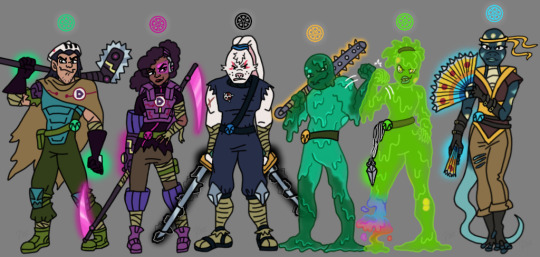
Some ROTTMNT fanbabies & apocalypse teens!
Don't read too hard into the parents, but I have my reasons and am mostly goofing around. For reals, do not come at me! I am just killing a little time with some cute babies because of that 87' Splinter clip and how the man wants some grandbabies. 😅
_____________________________________________________________
Casey Jr.- Raph x Cassandra.
Human passing with some turtle-like traits such as green skin patches, shell-like back scutes, a very pointy baby tooth, and above average strength/durability. Has 5 fingers and toes.
Ninpo glow is a green-blue/ teal.
Weapon: Chainsaw-Hockey-Stick
_____________________________________________________________
Ada- Donnie x April.
Human passing, with 4 fingers/toes, purple-tinted hair, and square-purple birthmarks around the eye and legs. Named after mathematician, Augusta "Ada" Lovelace. Middle name, Rosalind, is in homage to Dr. Rosalind Franklin who revealed the double helix structure to DNA.
Ninpo glow is magenta.
Weapon: Dual Scythe
_____________________________________________________________
Jotaro- Leo x Usagi.
Rabbit Yokai passing, save for the red-ear slider marks around his eyes. 4 fingers/ toes.
(I know it's not how names work, but I mixed Miyamoto and Hamato to make Hamamoto, and thought it sounded neat.)
Ninpo glow is black.
Weapons: Katana/Wakizashi (Usagi's swords)
_____________________________________________________________
Blobboid- Mikey x Sunita.
Slime Yokai passing. Is denser than most slime yokai, but is still malleable. Can also harden body to shell-like texture for defense. Has 3 fingers and blob-like feet.
"Blobboid" is a reference to Mikey's alternate superhero self in the 2003 series and also 99% the reason for this crack pairing!
Ninpo glow is peach.
Weapon: Kanabo
_____________________________________________________________
Rangeen- Mikey x Sunita.
Slime Yokai passing. Can manipulate the colors of her slime for advanced shapeshifting capabilities without the need for a cloaking brooch. Has 5 fingers and blob-like feet.
Name means "colorful".
Ninpo glow is lime-green.
Weapon: Rope-Dart
_____________________________________________________________
Sofonisba- Galizia x Mona.
Lizard Yokai. Born from an egg. Has 4 fingers and toes. No turtle traits, save a few similar markings on her skin and the passing of hereditary ninpo energy.
Ninpo glow is turquoise.
Weapon: War-Fan
(Used the Starla baby pose reference on baby Casey for the back pose!)
#rottmnt oc babies#casey jones jr#raphcass#leosagi#apritello#mikey x sunita#rottmnt galizia#mona feyrouz#dad raph#half turtle casey#rottmnt oc#rottmnt fanbabies#dont read into the pairs... its just for funsies#I can explain myself I swear!#roninreverie
203 notes
·
View notes
Note
Do Gallifryans/Time Lords have a similar chromosome structure as us humans? Are there any vast differences? I'd imagine they have at least double the chromosomes we have, or perhaps don't even have pairs, rather groups of three (e.g. XYZ) or something alike.
Chromosomal Structure
🧬 Gallifreyan Chromosomes + triple helix
Unlike a human's double-stranded DNA, we know that Gallifreyans rock a triple helix with 69 chromosomes arranged in three sets of 23. This triad structure introduces a level of genetic complexity that includes basic abilities related to time phenomena and psionic capabilities.
🌌 Rassilon's Strand
However, Time Lords take it up a notch. Upon completing their education at the Time Academy, Gallifreyans undergo a transformative exposure to the Eye of Harmony's time energies, integrating what we'll term as 'Rassilon’s Strand' into their genetic makeup. This is what makes a Time Lord.
This fourth strand provides the following abilities:
More stable regenerations: Slightly less worry about turning into a sentient cactus or something.
Time sense boost: Like becoming a living clock.
TARDIS BFFs: This strand is why they can bond with their TARDISes. Without it, time travel would be a no-go.
Matrix connection: Keeps you constantly logged into Gallifreyan Ancestral Memory Facebook.
🔬 Detecting and inheritance
You can't just spot this extra DNA strand with regular equipment - you need some fancy temporal scanning tech to see it. It's a form of temporal encoding, where the genetic information transcends physical structures and resonates with time itself. Plus, because it's artificially added and 'earned', 'Rassilon’s Strand' isn't passed down through genetic inheritance/normal reproduction.
🏫 So ...
So, in short, Gallifreyan/Time Lord DNA is like the deluxe edition of genetics. More complex, more strands, and packed with stuff that make time travel a genetic obligation.
Hope that helped! 😃
→🫀Gallifreyan Anatomy and Physiology Guide (WIP)
→⚕️Gallifreyan Emergency Medicine/Monitoring Guides
→📝Source list (WIP)
-------------------------------------------------------
》📫Got a question / submission?
》😆Jokes |🫀Biology |🗨️Language |🕰️Throwbacks |🤓Facts
》📚Complete list of Q+A
》📜Masterpost
If you like what GIL does, please consider buying a coffee to help keep our exhausted human conscious for future projects, including complete biology and language guides.
#doctor who#gil#gallifrey institute for learning#dr who#dw eu#gallifrey#gil biology#gallifreyans#ask answered#gallifreyan biology#whoniverse#time lord biology
18 notes
·
View notes
Text
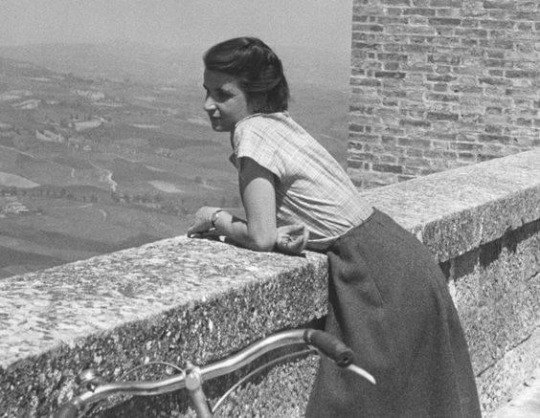
While J. Watson and F. Crick are widely known for their discovery of the DNA double helix, Rosalind Franklin's crucial contributions, particularly her X-ray diffraction images of DNA, were essential in deciphering its structure. Her work was pivotal, yet often overshadowed in historical accounts.
15 notes
·
View notes
Text

Rosalind Franklin (1920-1958) was a British chemist and X-ray crystallographer whose work was crucial to the discovery of the double helix structure of DNA.
Here are some key facts about Rosalind Franklin:
She captured the famous "Photo 51" X-ray diffraction image of DNA in 1952, which revealed the double helix structure. However, her contribution was initially unrecognized.
She was an expert in X-ray crystallography and studied the molecular structures of DNA, viruses, coal and graphite.
Her work at King's College London, using X-ray diffraction techniques, provided important insights into the helical structure of DNA.
Her data and insights helped guide Francis Crick and James Watson in deducing the double helix model of DNA's 3D structure in 1953.
Franklin's contribution to the discovery was largely unacknowledged for many years due to the sexist attitudes of the time. Watson and Crick shared the 1962 Nobel Prize with Maurice Wilkins.
She made pioneering use of X-ray diffraction studies of viruses, laying the foundations for structural virology.
She died of ovarian cancer in 1958 at the age of 37, before she could be formally recognized for her seminal work on DNA structure.
Rosalind Franklin's meticulous X-ray work and skills in crystallography provided indispensable data that led to one of the greatest discoveries of the 20th century - the double helix structure of DNA.
#stickers#sticker art#sticker design#rosalind franklin#dna discovery#dna#biotechnology#science#sciart#scicomm
11 notes
·
View notes
Text

chapter thirty-four — no more secrets
➝ sometimes the fear of losing someone to stupid ideas drives people to do stupid things.
➝ word count: 3,1k
➝ warnings: none
APRIL, 2017
An early spring breeze ruffled Elisabeth’s hair as she walked hand in hand with Toto, across the crosswalk that led to the Mercedes-Benz museum building. It was in front of the company’s headquarters, and was a massive complex with not only offices, a factory, a dealership, and the museum, but also the imposing Mercedes-Benz Arena, where the city’s Bundesliga football team played, though she couldn’t remember the name of it.
In reality, Elisabeth knew very little about football. She had learned the basics from Mathias, who never missed watching FC Barcelona games. He was a fervent supporter of the Catalan team, and had named several of the family’s pets after its players. Mathias’ passion for the sport had certainly not come from Niki, but from Tilman, their uncle, and Mathias was already working to turn his own children into lifelong Barça fans. They’d had Barça clothing from infancy, and both of them learned the team anthem almost as soon as they’d learned to talk.
As Toto and Elisabeth walked toward the large metal-clad building, the man with them made small talk about the club — VfB Stuttgart, apparently — and their difficult season. The man with them was Ola Källenius, a Swede, and part of the board of directors of the Mercedes-Benz group. Toto and Elisabeth had stopped in Stuttgart to meet with him on the way back home from the Bahrain Grand Prix.
— However, I didn’t want to just talk with you about Stuttgart's misfortunes this season, but something else — Ola said, as they approached the entrance to the building — Something of interest to you, or at least, of interest to Toto.
As they all entered the atrium, Elisabeth couldn't help but be impressed by the building’s architecture. It looked large from the outside, but it looked even larger on the inside with the triangular-shaped panes coming together to give the visual impression of the room looking bigger than it was. The elevators stood out against the concrete walls, making them look like silver capsules, waiting for their passengers.
“This place is a work of art”, she thought, as the executive greeted a man warmly.
— Toto, Elisabeth, this is Pádraic, one of the museum guides. He knows everything about everything in here, right?
— I like to think so, Ola — the man replied, his accent indicating he wasn't German — It's nice to meet you.
— The pleasure is ours, isn't it, Liesl?
Elisabeth limited herself to a nod as she shook the man's hand.
— Which route would you like to take?
— We'll have to skip the traditional tour today, Pádraic. Toto and Elisabeth have a flight scheduled for later and they don't have time to see everything. However, they’d like to see the racing car collection — Ola replied, making the guide smile.
— Very well, would you follow me? — he said, gesturing with one hand. Along the way, Pádraic gave a quick explanation of the museum's internal structure, which had been planned to resemble a double helix, like DNA, with the outer section devoted to thematic collections, and the inner section to the history of the brand.
After taking an elevator to the second floor, they headed to a section of the museum that resembled a banked curve. It was built as an homage to ancient European chariot racing tracks, he said, and the steepness of the curve made it more challenging. The banked track in the museum was made to display an array of silver cars, with one or another colored model, corresponding to the most modern cars.
— These are our racing cars. Since 1894 we have records of Mercedes taking part in motor racing for the purpose of proving the reliability of the brand's engines. It was the main form of advertising for cars that existed for motor vehicles. It was how the company built its brand until the birth of the Silver Arrows.
Glancing at Toto out of the corner of her eye, Elisabeth noticed that he looked delighted, like a child let loose in a toy store. There was an undeniable twinkle in his eye and goofy smile on his face. She nodded as the guide talked, listening intently.
— Here we have the four-cylinder, 120-horsepower Benz Grand Prix, which was the first car developed exclusively for racing. There, we have the 1914 version, also with four cylinders but with a 274 cubic inch engine and, in front of it, the W25, which was the car that gave us the nickname “The Silver Arrows”. The mechanics had to strip all of the paint from the body to make it lighter, leaving only exposed aluminum — Pádraic explained, pointing to each of the cars and giving them a brief explanation.
As they walked along the curve, Elisabeth couldn't help but notice something odd about the exhibit. Just ahead, there was a space between two cars that was clearly bigger than the others. It was as if something was missing there, one of the pieces of the museum.
— That one has a funny story. With the dominance of German cars in racing, the Italian motorsport federation decided to restrict racing to only cars with 1.5 liter engines, which were not made by any German manufacturer. So, Mercedes decided to develop a car with these specifications in just eight months. In the end, the W165 was born, which won the Tripoli Grand Prix, in 1939.
— I think you have a little more time than that to develop the car in Formula 1, right Toto? — the brand executive asked, smiling.
— It revolves around this time, Ola. Of course, everything has become easier than before, with technology and all. It doesn't detract from their achievement of making a car in such a short amount of time.
A few steps later, Elisabeth's curiosity won out.
— Why is there such a big space there? — she asked.
— Ah, yes, that is where the 300SL usually is. It was our first car to compete after the Second World War, and it won the Carrera Panamericana in Mexico. But it was pulled from the exhibition at Ola's request for a bit of a… revision.
— Revision? — she asked, raising an eyebrow.
— Yeah, it's going to Italy to participate in the Mille Miglia, in honor of the 65th anniversary of its victory in Mexico — Ola said, smiling — It will be the car that Aldo and Toto will use for the race.
She blinked. Elisabeth had no idea what the Mille Miglia was, or why Toto would be involved in it. However, swallowing the lump in her throat, she just forced a curious smile.
— Use? You mean, race?
— Exactly. We received an invitation from the race organizers, talking to Toto at the beginning of the year, he offered to drive it, along with Aldo.
— I'm really glad you got the car cleared for us — Toto said, looking genuinely pleased about that — It's going to be fantastic driving it around Italy.
— And when will that be? — Elisabeth asked, doing her best to hide her displeasure at only just now finding out that Toto would be driving in a race.
— In May, Liesl — Toto replied immediately, smiling — And I can't wait.
— I can imagine — Elisabeth said, letting go of his hand and putting it in the pocket of the tailored pants she was wearing, something churning in her stomach.
After saying goodbye to Pádraic and Ola, the two went to the car they had rented on arrival in the city and made their way back to the airport, where one of Laudamotion's private jets would take them back to England. During the entire drive to the airport, Elisabeth remained silent, completely immersed in her own thoughts. She only gave Toto monosyllabic responses.
She was trying to remember if he’d told her or not. She thought she would have remembered if Toto had told her that he was going to drive a car that was almost as old as her father, but absolutely couldn’t recall, which could only mean one thing.
Toto had hidden it from her.
After returning the car to the rental lot at the airport, the two of them walked to the private flight boarding terminal in virtual silence. Toto had tried to strike up a conversation with her, but Elisabeth was still so deep in her own thoughts that she practically ignored him.
“Why, Toto?”, she asked herself, as she climbed the stairs up to the jet.
Elisabeth settled into one of the armchairs on the plane and took off her shoes. Toto sat in the seat across from her. She took a few seconds to watch him settle into place, strapping himself in. She arranged the briefcase she’d brought on the seat next to her.
“Why did you hide this from me?”, she wondered.
Even when they reached cruising altitude, Elisabeth didn’t get up or move. She was too distracted by the unanswered questions inside her mind.
— Liesl?
Toto's voice snapped her back to the present. She felt something tightening in her chest.
— Yes?
— Are you okay?
— Yeah — she replied quietly. He looked at her with a skeptical expression on his face.
— It doesn’t look like it.
She blinked.
— What do you mean?
— You've been quiet since the museum visit. Quieter than usual.
— Any problem with my silence? — Elisabeth asked, in a slightly harsher tone than she ‘d intended. And she saw in his expression that she was too harsh.
— No, none… It's just… You're only quiet like that when you're upset.
She pressed her lips together, one hand moving up her arm to the crook of her elbow, pinching the skin there. It was an almost natural reaction of hers to situations that made her anxious or stressed, especially conflict. She could feel that conflict was coming.
— Well, since you asked, I am pretty upset, Toto — Elisabeth replied dryly.
— Upset about what?
— What do you think?
— I don't know, there's so much...
— If you need a tip, think about what you're going to do in Italy in May.
Toto blinked, finally connecting the dots.
— Are you upset about the Mille Miglia?
— No, Toto. I'm… Fuck…
— You are what?
— Sad. Disappointed. Deceived. Betrayed.
The last word made him straighten up suddenly.
— You know I would never betray you...
— Then why did you? — she cut him off.
— Elisabeth…
— Toto, you know my fears about racing, my misgivings. You know that as much as I like racing, competing, winning, above all that, I love you. And you know my biggest fear is losing you.
He continued to stare at her in silence.
— I was honest with you, I told you all about my fears surrounding motorsport and racing. We talked about the Nordschleife, about my fears and about your accident and my father's accident. And I remember exactly what you said to me that night, every word. You promised me that I wouldn't lose you to your stupid ideas.
— I know, Elisabeth...
— Then why did you decide to take part in this race? We agreed that we would talk about anything like this that came up. You promised me this, Toto!
He was silent for a few seconds.
— I forgot.
Elisabeth couldn't resist a sardonic laugh.
— You forgot?
— Yes, Liesl, I forgot and I apologize for…
— Toto, do you really think I'm going to believe that excuse? Do you really think I'm going to believe that you just forgot to tell me you were taking part in a fucking race?
— But that's what happened, I received Ola's invitation just now in...
— He said you offered yourself at his last visit — she interrupted him — Ola was last at the factory in January, Toto. You've known this since January. You knew and you hid it from me till now. It’s April!
— I didn't hide it, Elisabeth!
— And I even know why — she continued — You did it because you thought I was going to say no, so you thought it was better to hide it from me.
— Fuck, give me a minute to explain — he exclaimed, slapping his legs with his hands. Elisabeth was not at all interested in granting that request.
— And what would be your excuse for spending a week away from home? What would you say to me so I wouldn’t discover your real intentions? — she snarled.
— I was going to tell you, but I...
— “Hey, Liesl, listen, I'm going to Italy to fuck some whore, I'll be back next week” — Elisabeth spoke in a deeper voice, in a crude attempt to imitate him.
That was the last straw for him.
— God damn it, Elisabeth! — Toto yelled, getting up from his seat — Shut the fuck up!
Elisabeth tried to answer, but his expression made her stop. He wasn't just upset with her. There was something else in his eyes than what was on his face.
It was pain. Heartache.
— You can say whatever you want about me, Elisabeth — Toto snarled, one finger raised — You can call me an idiot, an ass, a selfish person, an asshole, anything that crosses your fucking mind. But never, never call me dishonest!
She felt a lump tighten in her throat.
— I was wrong. I was wrong not to tell you about the race. Truthfully, I was a bit afraid that you wouldn't agree to it, but I didn’t hide it from you. I was going to tell you. I brought you here to tell you about the race, the car, everything. I was going to invite you to come with me but… Fuck!
— Toto...
— No. Listen to me, Elisabeth! — he spat — Did I fuck up? Yeah, I did. I've fucked up a lot in my life. Not just with you, but with Stephanie, with the kids, with my mom, with my sister, with a lot of people. But I’ve never been dishonest in anything I do, Elisabeth. Not once in my life.
— I did not say…
— That I was dishonest? And saying that I'm going to Italy to fuck whores, to cheat on you? Cheating is dishonesty, isn’t it?
She didn't know how to respond.
— I never cheated on you. You're the only woman for me. Even when I was with someone else, all I could think about was you. Even when I was fucking someone else, all I could imagine was being with you. I would never cheat on you, Elisabeth, because that would be dishonest of me.
— Isn't lying a kind of dishonesty too, Toto? You lied to me.
— You've lied to me too, Elisabeth. You lied about your feelings for me on that phone call on Christmas Eve. And I kept believing in you, even though you broke my heart into thousands of pieces. I kept loving you even if you didn't love me back.
— That doesn't count…
— Doesn't it? You’ve hidden plenty of things from me. The fights with Mathias, the things my mother told you? Weren’t those lies by omission?
— Me hiding things so I don't upset you is different from you hiding things because they're stupid! — she argued.
— This race isn't stupid, Elisabeth.
— Is it not? Isn't being away from home for almost a week, stuffed in a tin can with four wheels stupid?
— It might be stupid, but I want to do it! I've always wanted to be in that race, drive that car, and stupid or not, I'm going to go. I'm not going to give up doing this just to satisfy your spoiled little girl ego and, honestly, I don't even know why I'm justifying myself. I don't owe you any satisfaction.
Something inside Elisabeth's chest ached.
— You know what? Go ahead. Go drive that fucking car in Italy. When you get in another accident and end up in the hospital again, you’ll call me. And if you think I'm going to drop everything to run to your side, you're sorely mistaken — she spat.
Toto’s nostrils flared, lips pressed into a thin line, his jaw clenching. After a few seconds, he settled back into his seat, his eyes fixed on the window beside him.
It was then that Elisabeth realized that maybe she had gone too far.
The rest of the flight after the fight had been silent. After landing in Oxford, the two drove home in silence. After parking the black Mercedes C-Class in the garage, Elisabeth got out of the car and went to the trunk to get the luggage she had taken for the two weeks she had been away. The suitcase was heavy, but the last thing she wanted was to ask for Toto’s help with it.
She wasn't a spoiled little girl.
— Need help? — Toto murmured beside her.
— No — she said dryly, setting her suitcase on the ground and into the house. Pulling the handle, she dragged the luggage up to the second floor, pausing a few times along the way to catch her breath. She was dropping her suitcase in the closet when Toto arrived in their bedroom with a small bottle of water in his hand. As she caught sight of him in her peripheral vision, she felt something tighten in her chest.
— Are you going to shower now?
— You can go if you want — she murmured, as she went to one of the shelves to get something to wear — I'm going to shower in the other bathroom.
— Why?
— As far as I remember, Torger — Elisabeth turned her face to him, staring at him for a few seconds — We don't owe each other satisfaction.
She grabbed her panties and, in complete silence, left the room, heading for the bathroom in the upstairs hallway. After showering and changing into a pair of shorts and an old University of Vienna T-shirt that she liked to use as pajamas, Elisabeth went to the guest bedroom, a room they always left ready to receive a family member or their friends when visiting them in England.
Sitting up in bed, she allowed herself to take everything in. The decor of the room was cold and impersonal. The walls were light, everything was very neutral-looking, and said that it was not a space to be occupied permanently, only for short visits. Not even Benedict and Rosi slept there, but they had their own rooms in the house, arranged and decorated according to their tastes.
Elisabeth shouldn't be there. But at the same time, she needed to be. She couldn't bear to sleep in the same bed as Toto that night, smelling his cologne and feeling the warmth of his skin. Settling down on the mattress, she sighed, trying to shake the tightness she felt in her throat away. But with each breath, she felt the agony rise in her chest and tears fill her eyes.
Finally, she broke down into sobs.
#toto wolff#toto wolff x oc#formula 1 fic#formula 1 fanfic#formula one fic#formula one fanfic#f1 fic#f1 fanfic#f1 x oc#formula 1 x oc#wlffog#natsversion#scwlff
63 notes
·
View notes
Text
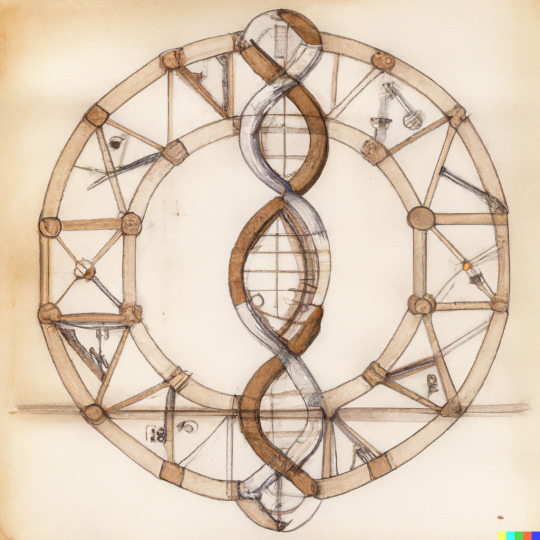
Generated using DALL-E on OpenAI:
A sketch by Leonardo Da Vinci of the double helix structure of DNA, archival print
242 notes
·
View notes